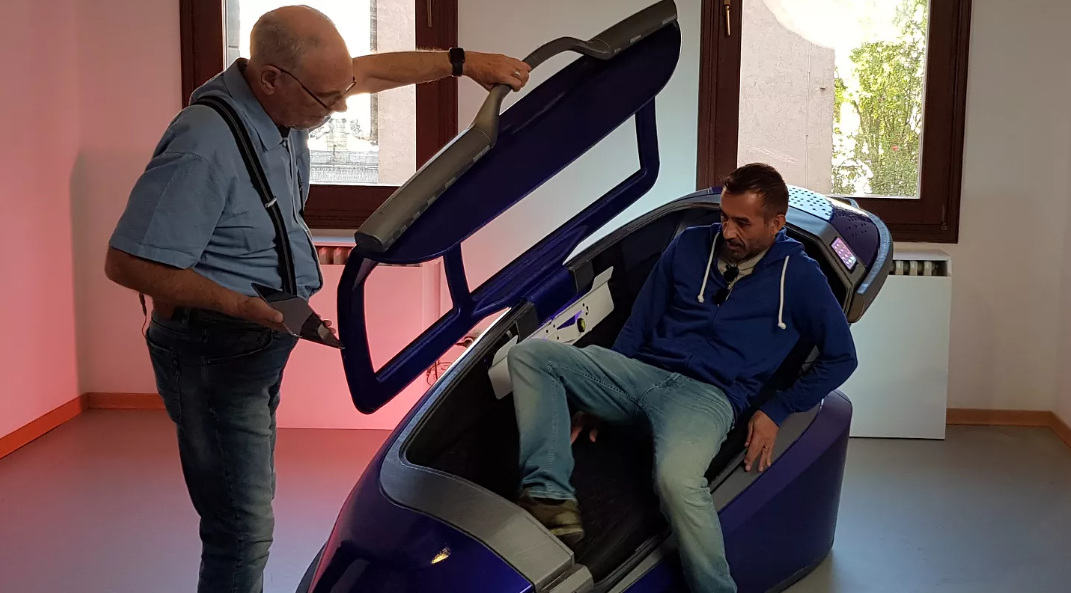
Are you concerned about knowing how a suicide pod works? Well, it has been the talk of the town a lot in recent years. It promises a swift and painless demise and is at the center of conversations around assisted suicide and euthanasia after Switzerland announces to legalize the machine.
Suicide pods, which have a sleek, capsule-like appearance, are outfitted with technology that enables people to take their own lives quietly, usually by
- depriving themselves of oxygen.
Supporters contend that they provide a respectable and self-determined means of passing away, particularly for individuals with terminal conditions. At the same time, detractors raise moral questions regarding possible abuse and the social repercussions of legalizing assisted suicide.
The first suicide pod was unveiled in 2019 by “Philip Nitsch,” also known as “Dr. Death.” He is also the founder of Exit International.


How a suicide pod works
There are two sides to this controversial invention since the world came to know about it: people are either interested in knowing how a suicide pod works or the debate about ethical or moral factors in making it legal worldwide.
Functionality
One of the main concerns: When an internal button is pressed, the pod quickly lowers its oxygen content while rapidly filling its chamber with nitrogen.
In about ten minutes, this procedure leads the victim to lose consciousness and pass away.
Keeping in mind how this technology works, there are also discussions regarding its pros and cons. We can discuss a few of them.
Follow the link to learn more about functionality of how a suicide pod works https://www.financialexpress.com/world-news/what-are-suicide-pods-in-switzerland-know-their-function-and-risks-see-pictures/3559082/
Pros
- A Sober end to the life
Legalizing suicide pods can provide those with terminal illnesses or excruciating pain with a calm, pain-free, and respectable option. It respects individual autonomy and human rights by granting people the opportunity to choose how they want to live and die.
- A full stop towards Painful suicide options
Suicide pods offer a medically supervised and controlled option that may lessen the usage of traumatic or violent methods of suicide. This could lessen the person’s bodily and mental pain as well as the anguish experienced by their family and first responders.
- Measuring out the Health Care Resources
A legal, controlled way for terminally sick individuals to end their lives could ease the burden on healthcare systems by providing resources to those who choose life-extending treatments.
Cons
- Fear of Misuse
How these pods might be accessed and whether sufficient protections can stop abuse or coercion are issues. People who are vulnerable, such as those who struggle with mental illness or don’t have the right assistance, may use the pods improperly.
Moral and Ethical Considerations
Ignoring the aspects of how a suicide pod works or how it can help ease the pain of elderly or even young patients on the verge of life or death, significant ethical concerns are brought up by the legalization of suicide pods. According to its detractors, it might mainstream suicide, minimize the worth of human life, and put pressure on weaker people to choose death even if they are not really committed to the choice.
- Impact on Organizations Working for Suicide Prevention
It will have a huge impact on organizations working for suicide prevention for years and years as people, elderly or young, going through any kind of mental or psychological health issues that can be cured and bring them back to a healthy life have an option to end their life in a legal way.
It might mainstream suicide, minimize the worth of human life, and put pressure on weaker people to choose death even if they are not really committed to the choice.
you can learn more about the Pros and cons of assisted dying by followinghttps://pubmed.ncbi.nlm.nih.gov/9179959/
The Controversial Suicide Pod of Switzerland
Putting aside the functionality, or how a suicide pod works. A new chapter of debate has started recently in Switzerland, which is long renowned for its progressive views on assisted dying.
Switzerland allows terminally ill individuals to choose physician-assisted suicide under very rigorous rules thanks to initiatives like Dignitas. These limits will likely be pushed even farther with the release of the suicide pod, a sophisticated, 3D-printed gadget that induces hypoxia (a lack of oxygen) to allow people to pass out painlessly. Because this pod can be self-administered without a doctor’s supervision, it may make the process simpler and more accessible.
The use of suicide pods is becoming legal in Switzerland, which has sparked heated discussion. Proponents contend that the pods provide terminally ill patients with a more respectable, painless, and independent means of ending their lives. Supporters argue that it could allow people more control over how they die by lowering the need for direct medical involvement.
Opponents, however, raise moral questions, contending that the pervasiveness of these gadgets may diminish the significance of human life. Opponents worry that those who are weak, such as those who struggle with mental health concerns, or have not the exact idea of how a suicide pod works, might be forced or persuaded to use the pods. The discussion highlights a larger social concern on how to strike a balance between protecting people’s rights to privacy and preventing the misuse of euthanasia technologies.
What happens if anyhow the machine malfunctions?
A research institute in Massachusetts conducted research on these devices in 2022 to know how a suicide pod works and published a report that if this machine malfunctions anyway and the person inside does not experience the unconsciousness, it could end in a painful death instead of some dignified departure.
Legalization of Suicide Pods in Switzerland and Other Countries
Because euthanasia and assisted suicide are strictly regulated, suicide pods are still prohibited in the majority of countries. People are mostly interested in either knowing how a suicide pod works or the debate about it being good or bad for society, but its use is now prohibited in countries like Belgium, the Netherlands, Luxembourg, and Canada; however, assisted dying is authorized in these states under certain restrictions. These countries demand the involvement of medical specialists, who are required by strict laws to deliver fatal medications to the patient.
Suicide pods are prohibited in nations where assisted suicide and euthanasia are still prohibited (such as the United States, the United Kingdom, and Australia, with the exception of some states like Victoria). If suicide pods were legalized, they would probably encounter severe legal obstacles.
Suicide pods are permitted solely in Switzerland, but as the technology gains traction, it could have an impact on future debates over euthanasia laws around the world.
What would you choose? A Suicide Pod or another Assisted Death Option
Medication-assisted suicide frequently includes a cocktail of medications that cause unconsciousness, which is followed by respiratory or cardiac failure. The medications are usually prescribed or administered by a doctor, and depending on the patient’s health, they can take minutes to hours to cause death.
On the other hand
With suicide pods, the user can self-administer the procedure by activating the pod if they learn properly how a suicide pod works: it increases nitrogen and decreases oxygen levels. Hypoxia (low oxygen) results in a painless death in a matter of minutes. Once the pod is started, no medical practitioner is directly involved in the procedure.

Conclusion
Every assisted suicide technique has benefits and drawbacks of its own. Medication and lethal injections depend significantly on medical supervision to ensure controlled, methodical deaths. Contrarily, keeping in mind how a suicide pod works, it highlights individual autonomy and a painless, self-administered procedure. The moral arguments surrounding these techniques continue to influence international conversations over assisted suicide legislation.
follow the links to know about the latest Gadgets
https://wikisinfos.com/2024/09/06/samsung-galaxy-s25-ultra-specs/
https://wikisinfos.com/2024/09/04/iphone-16-revolutionary-ai-features/
https://wikisinfos.com/2024/09/08/google-pixel-9pro/
Leave a Reply